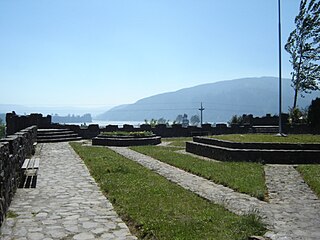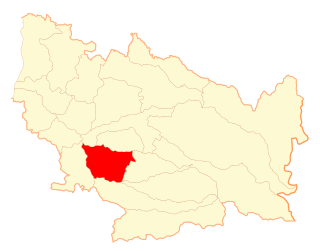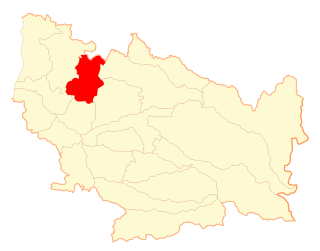
Cobquecura is a commune in the Region of Ñuble in the Province of Itata Chile's Region of Ñuble. The town is located on the northwest Pacific coast of the Itata Province about 420 km (261 mi) southwest of the national capital of Santiago.

Quirihue is a Chilean city in Quirihue, Itata Province, Ñuble Region. It is located about 72 kilometers northwest of Chillán and 410 km southwest of Santiago.

San Pedro de la Paz is a Chilean city and commune located in the Concepción Province, Biobío Region. It has some 80,447 inhabitants according to the 2002 national census. In 2005, the Pedro Aguirre Cerda avenue, the main avenue in the city, was completed. Most of the inhabitants of this comuna commute daily to Concepción – either by car, bus or train – over the Biobío River. It is considered to be part of Greater Concepción conurbation.

Lebu is a port city and commune in central Chile administered by the Municipality of Lebu. Lebu is also the capital of Arauco Province in Bío Bío Region. It lies on the south bank of the mouth of the Lebu River.
Tucapel is a town and commune in the Bío Bío Province, Bío Bío Region, Chile. It was once a region of Araucanía named for the Tucapel River. The name of the region derived from the rehue and aillarehue of the Moluche people of the area between the Lebu and the Lleulleu Rivers, who were famed for their long resistance to the Spanish in the Arauco War. Tucapel is also the name of a famous leader from that region in the first resistance against the Spanish mentioned in Alonso de Ercilla's epic poem La Araucana. Formerly belonging to the Ñuble Province, in the Yungay Department. Near the town of Tucapel is the Plaza de San Diego de Tucapel. The capital of the commune is the town of Huépil, moving the municipality from Tucapel in 1967. In Mapudungun the name Huépil means "To seize or to take by force".

Arauco is a city and commune in Chile, located in Arauco Province in the Bío Bío Region. The meaning of Arauco means Chalky Water in Mapudungun. The region was a Moluche aillarehue. The Spanish settlements founded here during the Conquest of Chile were destroyed on numerous occasions by the Mapuche during the Arauco War.

Ñiquén is a commune of the Punilla Province, located in the north of the Ñuble Region of Chile. Geographically, it is delimited by the Perquilauquén River to the north and the Ñiquén River in the south. Its boundary to the north is the commune of Parral and to the west that of Cauquenes both in the Maule Region, to the south with the commune of San Carlos, and to the east with San Fabian de Alico. The town of San Gregorio is the capital of this commune.

Hualqui is a Chilean city and commune in the Concepción Province, Biobio Region. It is also part of the Greater Concepcion conurbation, although it maintains a rural profile. It had a population of 24,333 inhabitants according to the 2017 census.

Santa Juana is a city and commune of the Concepción Province in the Bío Bío Region of Chile. It lies south and west of the Biobío River in the valley of Catirai and is 48 kilometers from Concepción, Chile.
San Rosendo is a Chilean city and commune in Bío Bío Province, Bío Bío Region.
Negrete is a Chilean town and commune in Bío Bío Province, Bío Bío Region. It is bordered by the commune of Los Ángeles to the north, Renaico to the south, Mulchén to the east and Nacimiento to the west.

Bulnes is a Chilean city and commune in Diguillín Province, Ñuble Region.

Ninhue is a commune and town in the Itata Province, Ñuble Region, Chile.

San Nicolás is a Chilean town and commune in Punilla Province, Ñuble Region.

Coelemu is a Chilean commune and city in Itata Province, Ñuble Region. According to the 2002 census, the commune population was 16,082 and has an area of 342.3 km2 (132 sq mi).

Ránquil is a Chilean commune in Itata Province, Ñuble Region. The communal capital is the town of Ránquil.

Quillón is a Chilean city and commune and Diguillín Province, Ñuble Region.

Santa Bárbara is a Chilean city and commune in Bío Bío Province, Bío Bío Region. In 2004 a great portion of its territory was taken off to form the new commune of Alto Bío Bío.
Rere is a town located in the commune of Yumbel, Province of Biobío, in the Bío Bío Region of Chile. It takes its name from the Moluche language of the indigenous confederation, or aillarehue, that occupied both sides of the Claro River and made up the greater confederation, or Butalmapu, between the Itata and Bio Bio Rivers. In 1603, then Royal Governor of Chile under Spanish rule Alonso de Ribera was to declare the erection of the areas first fort naming it Nuestra Señora de la Buena Esperanza. Later, in 1765, the town of Villa de San Luis Gonzaga de Rere was founded on that site by governor Antonio de Guill y Gonzaga. Today Rere sits 21 km west of the town of Yumbel.
Cabrero is a city and commune in the Bío Bío Province, Bío Bío Region, Chile.




















